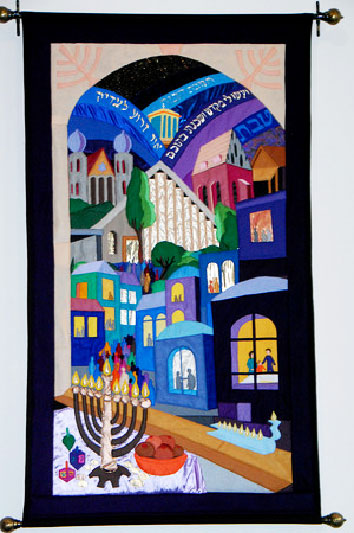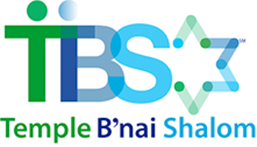Tapestry #4 Tevet: Chanukat Ha-Bayit – Dedication to the Home/Temple
 Look through my window with me. This is my tapestry, and the one that truly reflects my personal Jewish perspective. It is the way I see the world in hues of purple and filled with light that we kindle for God. I stand within my home, beside my family, fulfilling the mitzvah of Chanukah. We are commanded in the tradition to place our menorahs on the windowsill, to show the world we are Jews. The dreidels and gelt and jelly-donuts (Israelis don’t do latkes, they do jelly donuts… as long as it is fried… the oil and cholesterol remind us we are Jews!) The candles burn brightly on the window ledge showing the world our festival of light and our Jewish pride. It is a miracle that we are here in freedom, celebrating the miracles of our freedom and survival from Judah Maccabee until now.
Look through my window with me. This is my tapestry, and the one that truly reflects my personal Jewish perspective. It is the way I see the world in hues of purple and filled with light that we kindle for God. I stand within my home, beside my family, fulfilling the mitzvah of Chanukah. We are commanded in the tradition to place our menorahs on the windowsill, to show the world we are Jews. The dreidels and gelt and jelly-donuts (Israelis don’t do latkes, they do jelly donuts… as long as it is fried… the oil and cholesterol remind us we are Jews!) The candles burn brightly on the window ledge showing the world our festival of light and our Jewish pride. It is a miracle that we are here in freedom, celebrating the miracles of our freedom and survival from Judah Maccabee until now.
Chanukat Ha-bayit is the Jewish value we gave to our artists, Bracha and Menachem Lavee, for this tapestry. Normally, this value is the obligation to have a mezuzah on the doorpost of a Jewish home, a command straight from the Shema in the Torah. Deuteronomy 6:9 “And you shall write them (my commandments) on the doorposts of your house and on your gates.” In its broadest Hebrew interpretation, this value of Chanukat Ha-bayit means “dedication to the Home with a capital “H”. Let me explain.
The Temple in Jerusalem at the top of the tapestry is the Mikdash, God’s dwelling place in our midst, historically, God’s home. “V’asu li mikdash, v’shachanti b’tocham” – from Terumah (Exodus 25:8) “ You shall make me a tabernacle that I may dwell among you.” We build a place for God to dwell. This is one of the most important Torah phrases of my life. It was the portion for my son, Jonah’s Bar Mitzvah. It guided me as we created B’nai Shalom and struggled to raise the funds to build this temple. I have dedicated my entire life to building a home for God … in my own life for my family, and for this amazing congregation. I have always heard this command from God as the mission statement for my life’s work. I wake up each morning to build God a tabernacle in the minds and hearts and lives of those I serve and for those I love.
Temple B’nai Shalom is in the center of the tapestry, as it is the center of most of our Jewish lives. We see the outside world from the “mikdash me’at”, the small sanctuary we create for God, that is our own home. From our home we see our second home, our temple which is a direct descendent of the Temple in Jerusalem located above. The two homes center our lives and ground us. When we are dedicated to both homes, and only when we are dedicated to both, can we consider ourselves good Jews. Many can be good people, but I truly believe that a good Jew must have a Jewish home and must belong to a synagogue. To fail to create, support, and sustain either home for God, diminishes Judaism and the Jewish people.
“Or Zarua latzaddik –light is sown for the righteous” is the phrase on the left. How can you call yourself righteous if you do not have a Jewish home with exclusively Jewish symbols and practices, a mezuzah on the door, and have your home an extension of the spiritual home that you support financially and in every other way? You can’t really be a good and righteous Jew unless you sustain those institutions for which generations have fought and died. It is that simple in my mind. There are three synagogues that were destroyed in the Holocaust between B’nai Shalom and the Jerusalem Temple. Their destruction has become our imperative to support and sustain Judaism in the free world. Every study of American Judaism teaches us that the synagogue, even more than the Jewish home, is the foundation stone of Jewish survival in American Jewish life. Once upon a time, the Jewish home was the cornerstone, but as we age, and many do not have traditional families, the synagogue has become the centerpiece of Jewish survival. Those who don’t belong and sustain will not be around in another generation or two. Those who don’t live exclusively Jewish lives of Torah and practice will not have Jewish descendents for grandchildren. Every recent study makes this perfectly clear.
What makes this a uniquely B’nai Shalom tapestry are the families in the dwellings – American dwellings with square windows or Jerusalem dwellings with rounded windows according to our artists… (or newer Fairfax County home dwellings with rounded windows if you choose!). We specifically asked for every kind of family to be depicted – singles and couples, those with children and those without. We offer our blessings to those with traditional mixed gender parent households, and those where same gender couples sow the light of righteousness, even in the darkness of prejudice and ugliness of self-righteous bigotry. Light shines in every home with God’s blessing at TBS.
Even my beautiful tree, which the Dettelbachs planted for me when we moved into this temple, is in the tapestry. Once again a tree of life and growth symbolic of how our community has grown from a small sapling supported by a stick into a thriving tree towering over the temple offering shade and beauty. This is the tree for me.
Chanukah begins on the 25th of Kislev and has since the second century BCE. It ends on the 2nd of Tevet, so we have used the month of Tevet in this tapestry. This year, Christmas and Chanukah come on the same day. It happens very rarely, but when it does it offers us a unique opportunity to affirm our Judaism, and to offer blessing and love to neighbors, friends, and relatives who will be celebrating their holiday. We must be ever mindful that their holiday is not our holiday. Their trees or lights cannot be on our temple, nor in our homes,which are also Jewish sanctuaries to God. The Jewish home is a sacred dwelling, and the greatest gift we give to ourselves and our children is helping them be safe and secure in a home rich with exclusively Jewish symbols. We are ever mindful that not all choices Jews make are Jewish choices. One only had to read about the perversion of Bar and Bat Mitzvah parties in the Washington Post this week, or be upset by the dual religious home featured as an example, to see that symbols and choices do matter. The national Christmas tree will never be a holiday tree, my tree, or something that should be paid for with tax dollars in my rabbinic opinion. It is another reminder that we are a minority in a culture that has loudly voiced its disapproval with the separation of Christmas from our schools and our states. We still have our work cut out for us. Just when we think we have won the war, new battles arise in the workplace, mall, or school that remind us that like Judah, the battles continue even after we win freedom to worship in our sanctuary. This nation does not belong to any one religious majority. We must be diligent in our efforts to survive the season of joy and light with joy and light in our hearts for all. It is not always easy.
Some of our members don’t want to put menorahs in their windows as the tradition demands. We need to show the world we are proud. The light must shine forth from the sanctuary and light the darkness of injustice. We, who have known our sacred Temple to be desecrated and destroyed, must work to insure that all may practice faith or the choice not to have one, in safety, freedom, and the light of justice. And this tapestry hangs all year round to remind us that we are obligated individually and as a religious movement to be a “light unto the nations”, every day of our lives.
What I love about this tapestry is the fact that home and synagogue, family and faith community are one. We are a seamless “home for God.” Chanukat Ha-bayit. May we always dedicate our homes to God, Torah, and the survival of the Judaism and the Jewish people, here and around the globe. May your homes glow with pride and the lights you kindle burn brightly with God’s blessings of love and the hope of lasting peace.
Shabbat Shalom.
